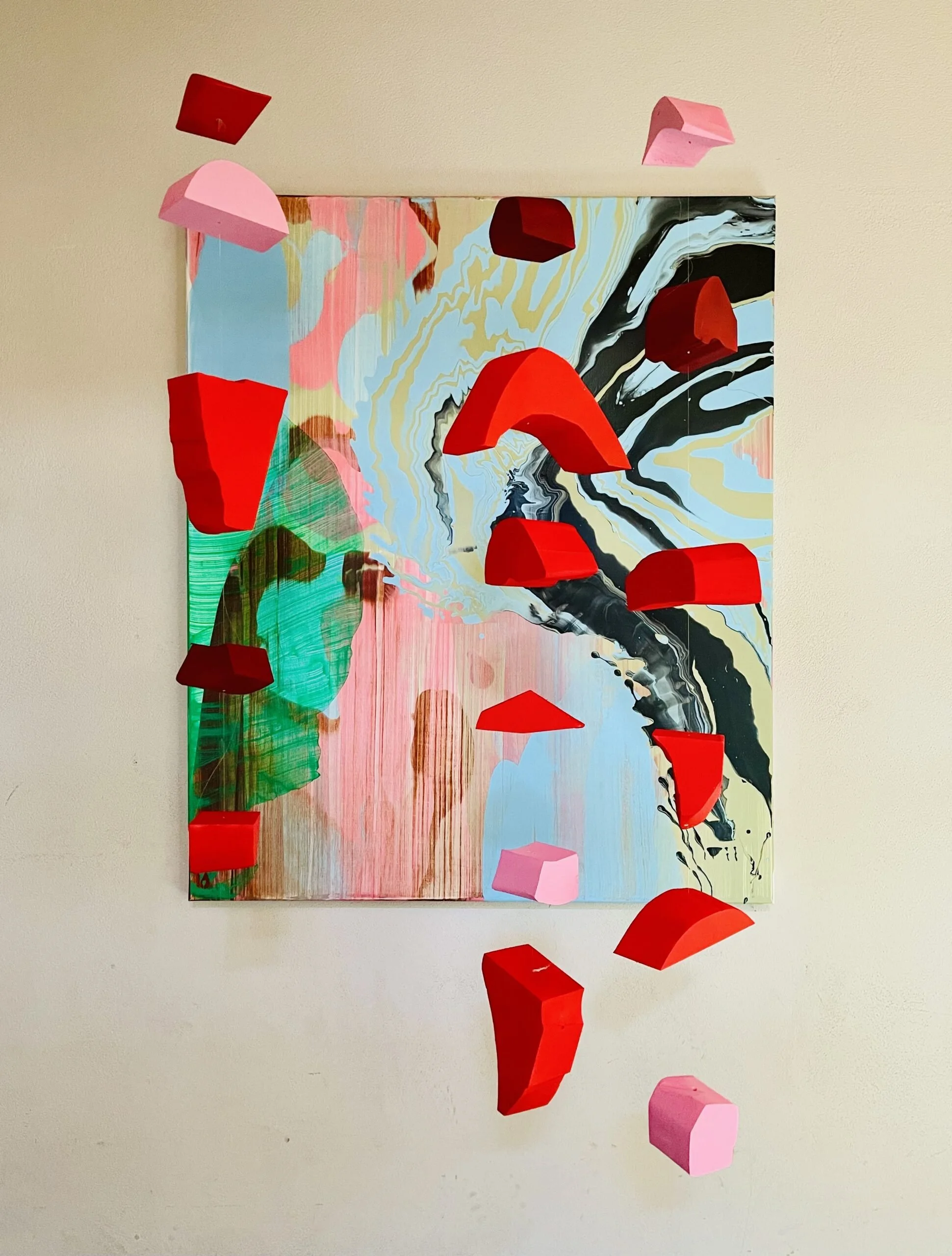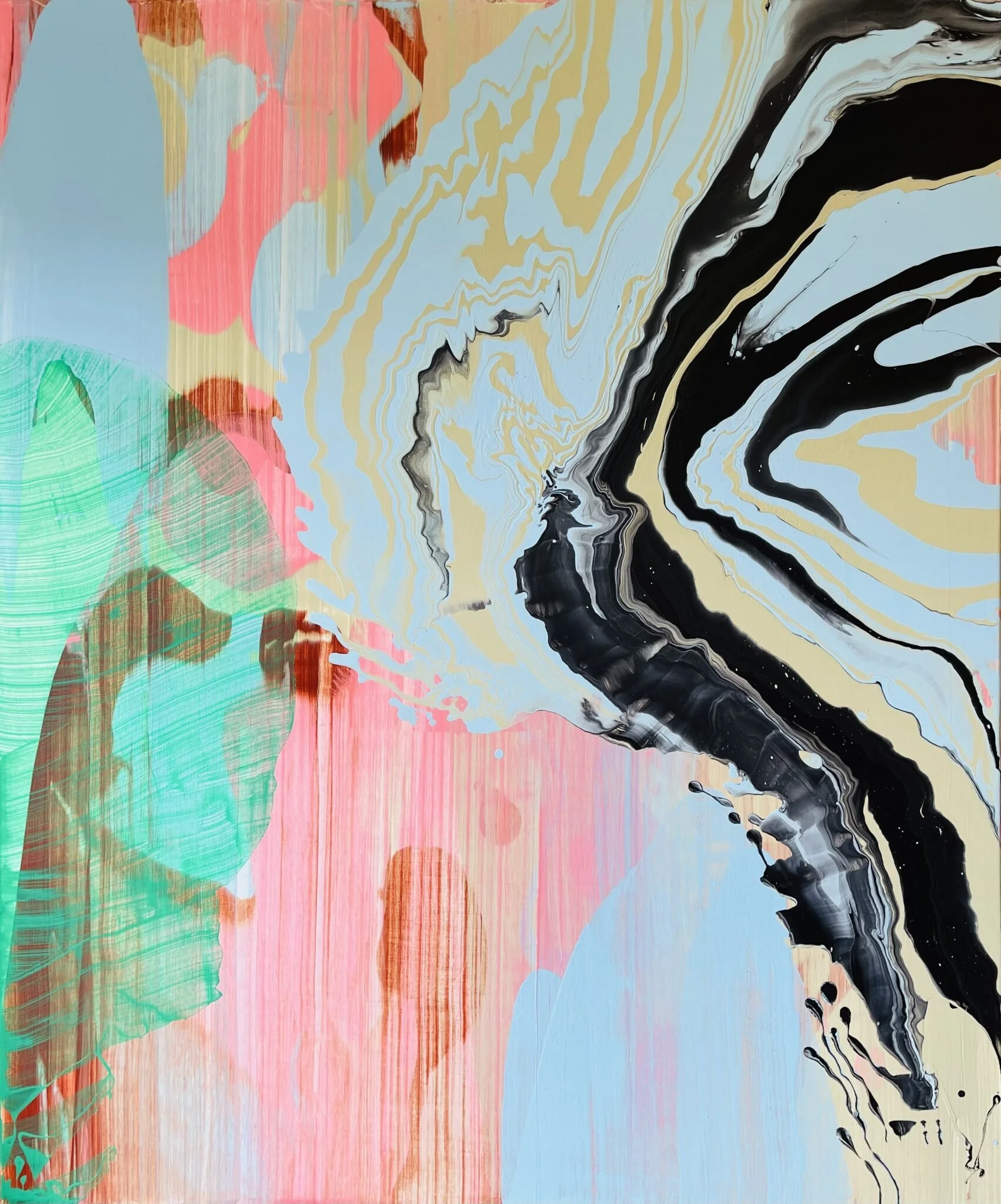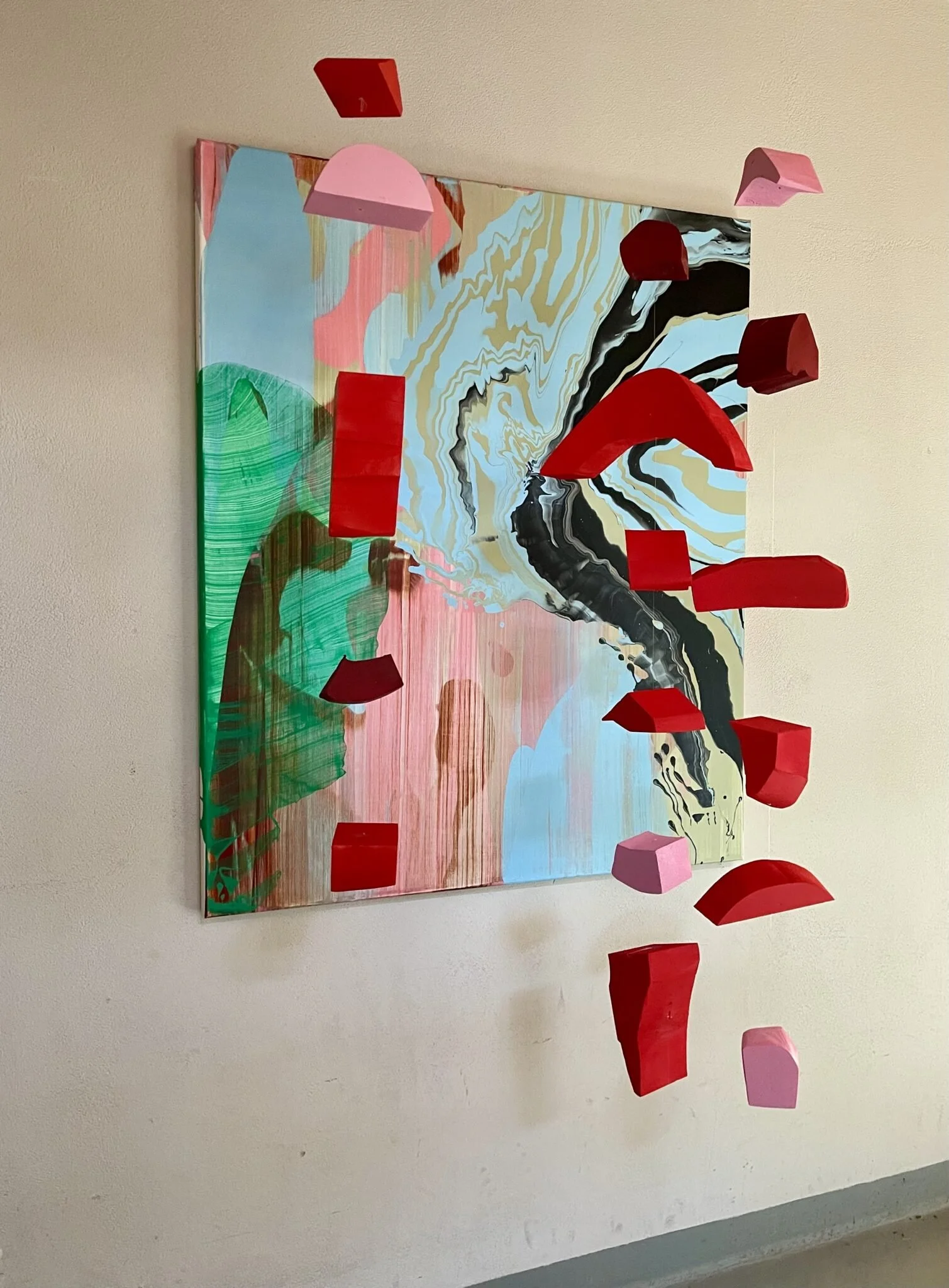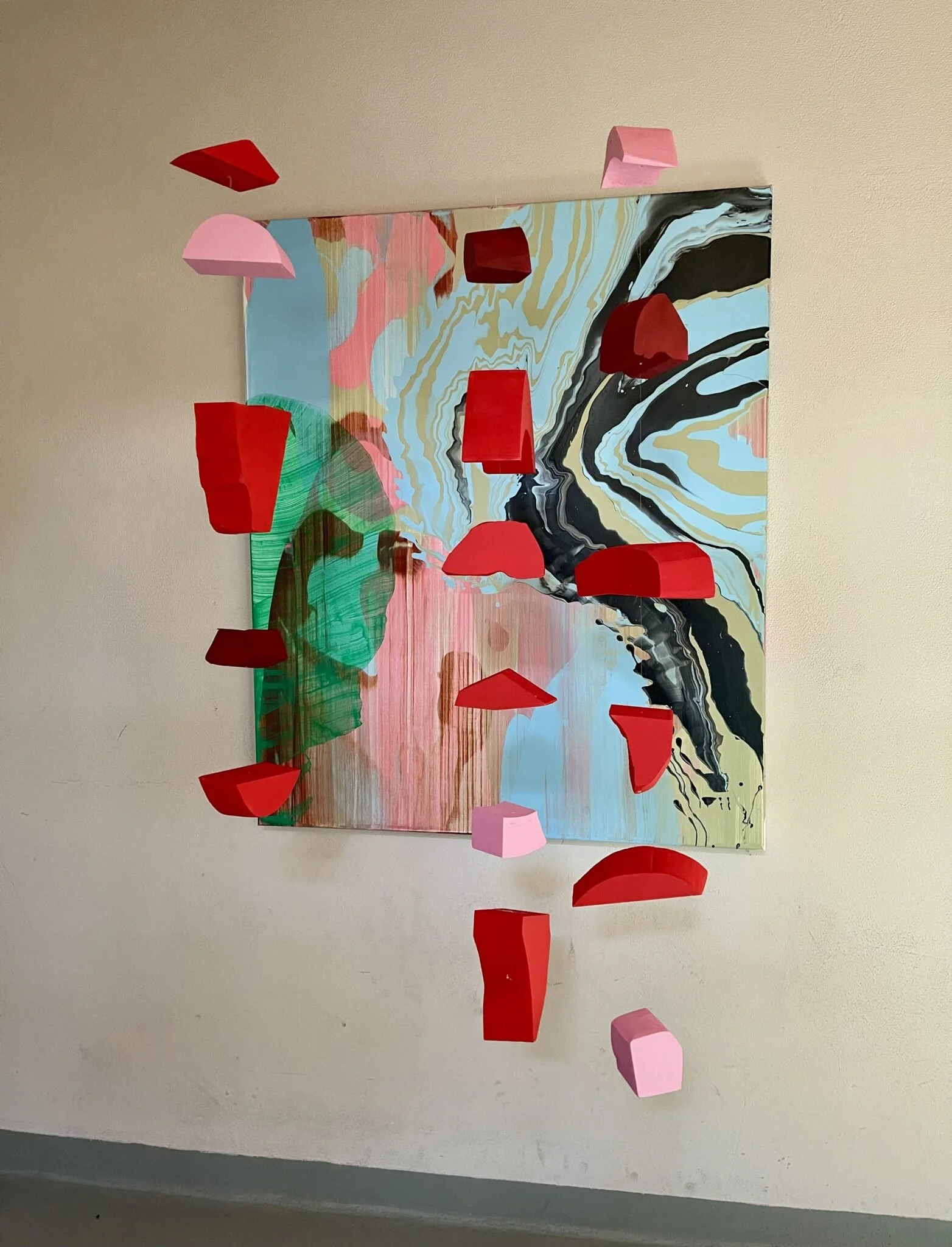Cover Image Flockhart K, Vox (2025)
Create a personal project in the studio developing your work. Use your Personal Project Proposal and tutor feedback to inform this body of work. This is your opportunity to make a drawing, or series of drawings, you are really excited by.
As I worked on my personal project I simultaneously circled back to P2. It contained practices involving conceptual art and layering.
The work of Caroline Achaintre (who I had studied in P2) had stayed with me throughout the course. I wanted to explore the idea of Achaintre’s canvas like tapestries to inspire a painting. How she used the wool similarly to the application of paint, layering and dripping, etc. And her notion of duality.
There is something both recognisable and abstract in her work. Forms from nature pleasing and disturbing. And the use of bright colours making the pieces appear symbolic rather than naturalistic.
This notion of duality has continuously helped me to navigate my work into interpretation rather than representation.
To quote Michael Ginsborg “I am trying to give myself permission.” (Ginsborg).
As I began to experiment a negotiation began to take place between the bones of my idea and an engagement with my materials. Initially this was paralysing. I had attached myself to an outcome, and although this had a value in that it gave me something to pursue, it soon became toxic. What I was producing practically had gone beyond what my minds eye wanted to see.
I had planned my process throughly, because I knew my chosen medium, pouring paint, is very unpredictable. But, I had not considered how to move forward once the unexpected happened.
To quote Mary Maclean from Rebecca Fortnums essay, “My understanding of materials is never complete, small or large departures from the expected behaviour nearly always take place.” (Maclean).
Fortnum continues to explain how “The quest to direct and harness the potential of the material is infinite and, for most artists, is a compelling part of the process…..this engagement with the medium and it’s potential to surprise fulfils an important role….” (Fortnum).
I needed to shift my focus. To take a deviation from the deep dive into the work, and come up for air.
I needed to put space between myself and the work.
Fortnum describes this as a ‘repositioning’. Revisiting the dynamic between the myself and subject was a necessary move on my part.
I related to Rachel Lowes comment (in Fortnums text) “I am particularly interested in work which you can’t put into words….you can talk around the work and you can talk about it but you cannot actually translate it into words.” (Lowe). She goes onto say that if she could write down what she wants to say she would be a writer, and this gave me confidence to pursue an uninhibited visual dialogue.
Im not trying to recreate a photographic image, or narrate written descriptions. Im looking for a visceral response to the paint, on the canvas.
To conclude, Lowe discusses the use of intuition in her work, and as I understand it ‘intuition can begin to unravel the concepts, but yet maintains its usefulness as a catalyst’.
I have found through this process that if something is too prescriptive it closes down. For me there needs to be a constant tilting motion going back and forth between structure and intuition, acting and reacting, known and unknown. And it’s within the space between the 2 polarities that my work emerges.
VOX
Vox, as in voice.
It is something and it is nothing.
It is known and unknown.
It was supposed be one thing, then it became another.
I worked methodically with intention, and then I let go.
Allowing for experience and discovery to compliment each other.
This painting has proved to me that I appertain with abstract narrative.
I had habitually associated security to representational elements, yet I continuously found the unexpected more interesting. I was continuously searching for a way to balance unexpected forms so I could create work that triggers an instinctual response (rather than recognition, or security in recognition).
Often these paintings would remain incomplete, I was afraid of their unconventionality.
Working continuously throughout the year, I built up a range of content. A mix of physical work and ideas. The last 3 projects I have undertaken have all had one common element and that is the theory of ‘activation’ which I encountered early in P8. The notion of a dormant painting or idea, being activated by another piece of work – To reignite the works trajectory.
With Vox, I was pleased with the progress of the painting. The layering and differing paint applications inspired by Anchaintre’s tapestries. Using a muted base palette. And the risk involved. I’d not been ultra prescriptive, trying to control every move. I worked intrinsically.
But then the painting discharged itself, and too early at that.
Fig.1 Flockhart K, Vox: Detail (2025)
And that was where the 3D elements came in. There was nothing more to add to the actual painting, but it needed something, a kick. Accents, some high key colour in the foreground. The hanging sculptural elements provided exactly that. Drama without overwhelming what was already there. Contrast but complimenting. A continuation of the unfinished conversation…..It works, but why…………
Unit 1.1 Fin
To be continued
List of Images
Cover Image Flockhart, K. (2025) Vox. [Pouring paint on canvas, styrofoam, spray paint, transparent string] In possession of: The author: Volleges.
Fig.1 Flockhart, K. (2025) Vox: Detail. [Pouring paint on canvas] In possession of: The author: Volleges.
Fig.2 Flockhart, K. (2025) Vox: Detail. [Pouring paint on canvas, styrofoam, spray paint, transparent string] In possession of: The author: Volleges.
Fig.3 Flockhart, K. (2025) Vox. [Pouring paint on canvas, styrofoam, spray paint, transparent string] In possession of: The author: Volleges.
Fig.4 Flockhart, K. (2025) Vox. [Pouring paint on canvas, styrofoam, spray paint, transparent string] In possession of: The author: Volleges.
Bibliography
Fortnum, R (2005) What is visual intelligence and how do artists use it?At:http://www.visualintelligences.com/visual-intelligence-how-artists-use-it.html (Accessed 05.08.2025).




